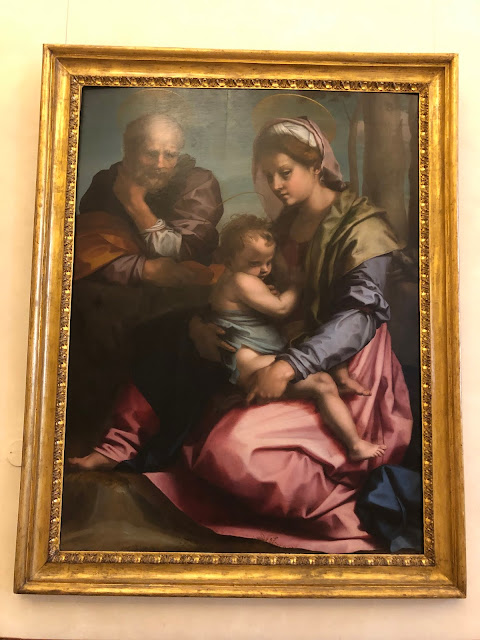【ローマ】バルベリーニ宮 ブロンズィーニョ、ティントレット、グレコ Roma - Palazzo Barberini : Bronzino, Tintoretto, Greco
ブロンジィーノによる『ステファノ4世・コロンナ』。
ローマのコロンナ家のステファノ4世が、黒光する鎧をまとって、兜に手をのせてポーズを取っている。
ステファノ4世は、ローマの貴族コロンナ家の人物だが、フィレンツェのコジモ1世の傭兵として働いていた。
ブロンジィーノは、鎧の細かい装飾の細部に至るまで、実に精密に描いている。
この絵画は1546年に描かれたと考えられているが、ステファノ4世は1548年にピサの地で亡くなってしまった。
"Stefano IV Colonna" by Bronzino.
Stefano IV of the Colonna family in Rome is posing with his hand on his helmet, wearing glowing armor.
Stefano IV, a member of the Roman aristocratic Colonna family, worked as a mercenary for Cosimo I in Florence.
Bronzino draws every detail of the fine decoration of the armor with great precision.
The painting is believed to have been painted in 1546, but Stefano IV died in Pisa in 1548.
ヴェネツィアの画家、ティントレットが描いた絵画で、聖ヨハネの福音書に描かれた姦通の女の物語の場面が描かれている。
姦通の罪で裁かれようとしている女性に対して、イエスが、一度も罪を犯したことのない人間が石を投げよ、と言ったという有名な場面。
ダイナミックな絵画構成で知られるティントレットの作品にしては、やや静的な印象を受ける。
おそらくティントレットは、神殿に立ち並ぶ柱と、神殿の中に立っている人々の姿を、同じような雰囲気で描きたかったのだろう。
A painting by the Venetian painter Tintoretto, which depicts the story of a woman of adultery in the Gospel of St. John.
A famous scene in which Jesus told a woman who was about to be judged for adultery that a man who had never sinned would throw a stone.
For Tintoretto's work, known for its dynamic painting composition, it gives a slightly static impression.
Perhaps Tintoretto wanted to portray the pillars in the temple and the people standing in them in a similar atmosphere.
エル・グレコの2つの作品が並べて展示されていた。
この2つの絵画はシチリアからもたらされた作品とのこと。シチリアは、スペイン系のブルボン家によって統治されていた時代があるので、その時にスペインから持ち込まれたのかもしれない。
以前は、エル・グレコ作品の模写と考えられていたが、最新の研究によって、エル・グレコの作品とされている。
Two works by El Greco were exhibited side by side.
These two paintings are said to have come from Sicily. Sicily may have been brought in from Spain at that time, as it was ruled by the Spanish Bourbons.
Previously thought to be a copy of El Greco's work, the latest research has made it a copy of El Greco's work.







コメント
コメントを投稿